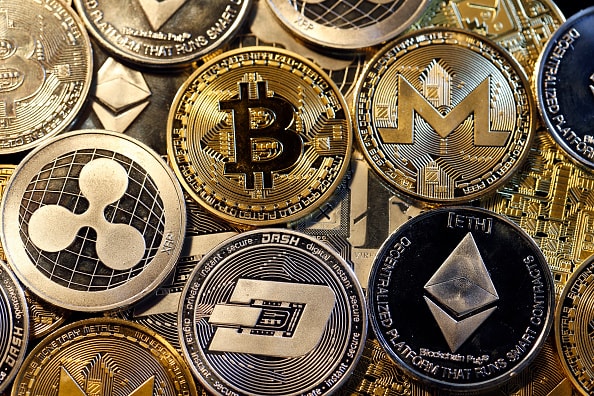Thursday, April 27, 2023
The University of Oxford estimates that they already consume 0.63% of the world's energy and result in higher electricity bills for households
By Miguel Ángel García Vega
It is a young technology at barely 14 years old. It was meant to change the world. But, for the time being, it has become an energy problem. The shine of cryptocurrencies is far from sustainable. The most famous of the hundreds in existence, Bitcoin, consumes 127 terawatt hours (TWh) of electricity per year. More than Norway in the same time period. According to The New York Times, there are 34 large-scale cryptocurrency mines in the United States alone, putting tremendous pressure on the power grid. What's more, their carbon footprint is the equivalent of having 3.5 million more cars on the country's roads, the tech NGO WattTime points out. In Texas alone, according to a study by the consulting firm Wood Mackenzie, the increased energy demand has caused households' electricity bills to rise 5%. That is, some $1.8 billion per year. "They are unsustainable," says Gavin Brown, professor of Financial Technology at the University of Liverpool (UK). He adds: "Oxford University estimates that cryptocurrencies account for 0.63% of electricity usage worldwide. This figure is slightly higher than Pakistan.” A single Bitcoin transaction takes ten minutes. By comparison, Visa processes 1,700 per second.
This all started in hopes of improving the planet, of course. In 2008, the enigmatic Satoshi Nakamoto created Bitcoin. A decentralized currency. In other words, its use and validation would be independent of the central banks. Instead of relying on those institutions to safeguard money, its transactions are verified by a sort of huge public ledger called blockchain. With this technology, in theory, intermediaries and commissions disappear. If it had existed in Picasso's Paris, it would have been considered a libertarian coin.
However, what initially almost seemed like a hobby has unexpectedly become a huge industry. The value of Bitcoin jumped from $1,000 in 2017 to $60,000 in 2021. Nevertheless, since that date it has fallen sharply. But there are two sides to every coin. "Bitcoin is an algorithm, and whenever you want to add a transaction to a blockchain (set of operations), you need to solve a complex cryptographic equation; that's called proof of work," explains Enrique Dans, professor of Innovation at IE Business School. It's simple. The "currency" consists of deciphering this equation. The problem? Competition is growing exponentially, and numbers are getting harder to find. Because only one miner will win the race. 99.9% will lose and waste energy needlessly. The only option? Put hundreds of thousands of computers (known as farms) to work on calculations. It therefore takes a lot of electricity to find the solution quickly and earn digital money. Miners who discover that solution are rewarded in bitcoins. It's the new gold rush of the 21st century. "I think they're exploiting the [electricity] system," warns Severin Borenstein, a professor at the University of California, Berkeley, an expert on energy prices. "But they will say, 'You know, the system was already there,' and I'm sympathetic to that in some ways."
However, this is not a sentiment that everyone shares. China banned bitcoin mining in August 2021. The country declared it "undesirable." Despite all this, clandestine mining is still underway. Golden technology continues to exist. In fact, it is controlled by the United States (38%), China (20%, despite the ban), Kazakhstan (13%), Canada and Russia, with 6% of the market. Thousands of people sift through numbers just as prospectors used to sift through river water, panning for gold. As if the competition were not enough, the number of bitcoins is finite: 21 million units. According to Enrique Dans, an estimated 97% has already been mined. The business will then be in the exchange of digital currency.
Bitcoin is certainly not the only cryptocurrency with a disproportionate energy expenditure. A single Litecoin transaction requires 18,957 kilowatts, and the Bitcoin Cash variant comes in at 18,522. It has inevitably come under fire from critics. "Bitcoin will always live in some dark corner of the internet, just like a virus protected in a bunker. There is no way of getting rid of every trace. We just have to convince as many people as possible to give it up and never raise it from the dead again," advises Pete Howson, professor of Environmental Science at Northumbria University (UK).

However, some might remember that passage from the Old Testament and the voice of Christ: "Lazarus, come forth." Ethereum (ETH) is the second largest cryptocurrency by market capitalization after Bitcoin. Last year, it reduced 99% of the energy required to solve the equation by changing algorithms. Instead of using miners, it relies on validators. Anyone with at least 32 ETH attains the rank of validator. The platform randomly selects them to approve the creation of new blocks. That is, to verify that user transactions comply with network standards. This program, which has taken years of work, is called "Merge." The advantages will include speed, cost and transaction capacity. And a smaller carbon footprint.
With this “green zeal,” some cryptocurrencies have introduced pre-mining to avoid IT waste. The system works in a similar way to fiat currency (the old banknotes) and stocks. A central authority creates a fixed amount of a currency and releases it carefully, depending on what is happening in the world or the economy. Other virtual currencies, such as Ripple, are generated from algorithms. This eliminates teams of miners searching for the solution at a tremendous speed with their thousands of polluting computers.
Within this unpredictable world, what experts call "market sentiment" is moving towards greener digital currencies. One option is charging a fee for the carbon generated whenever a bitcoin is acquired. The fact that Daniel Batten, one of the most popular (22,000 followers) climate activists on Twitter, is also an investor in this currency shows "that emissions in the mining of this cryptocurrency are decreasing rapidly,” notes Simon Peters, an analyst at the E-Toro brokerage house. Despite all this, Bitcoin remains far behind Ethereum on the path to sustainability. "And it's unlikely to change anytime soon," Peters clarifies.
There are also those who are willing to admit the enormous energy expenditure of these currencies and the effort they are making to limit it and use increasingly renewable sources. But we can't ignore the fine print. "It is urgent to reduce the energy consumption of industrial and production activity as a whole," says Albert Salvany, a consultant at PriorityGate, a company specialized in artificial intelligence. "But it is surprising how, at times, this concern does not extend to other activities that are far more important in terms of total volume per kilowatt-hour," he points out. Perhaps the reason is that all these complex equations are a socially sensitive issue. Many young people assumed it was an easy way to earn money. And they forgot that there was a lot of gambling involved. They rolled the dice, and almost everyone lost. The volatility (ups and downs) of these currencies is almost instantaneous. This also contains a valuable lesson. Norman Foster, perhaps the most influential architect of the last 50 years, grew up in a working-class neighborhood on the outskirts of Manchester (UK). His mother was a waitress. Someone once asked him: What did you learn from your parents? “Three words,” he replied. "Work, work, work." There are no shortcuts in life, not even digital ones.
Miguel Ángel García Vega
He has been writing for EL PAÍS for some 25 years, currently for Cultura, Negocios, El País Semanal, Retina, Suplementos Especiales, and Ideas. His texts have been republished by La Nación (Argentina), La Tercera (Chile) or Le Monde (France). He has received, among others, the AECOC, Accenture, Antonio Moreno Espejo (CNMV) and Ciudad de Badajoz awards.
¿Te ha parecido interesante?





